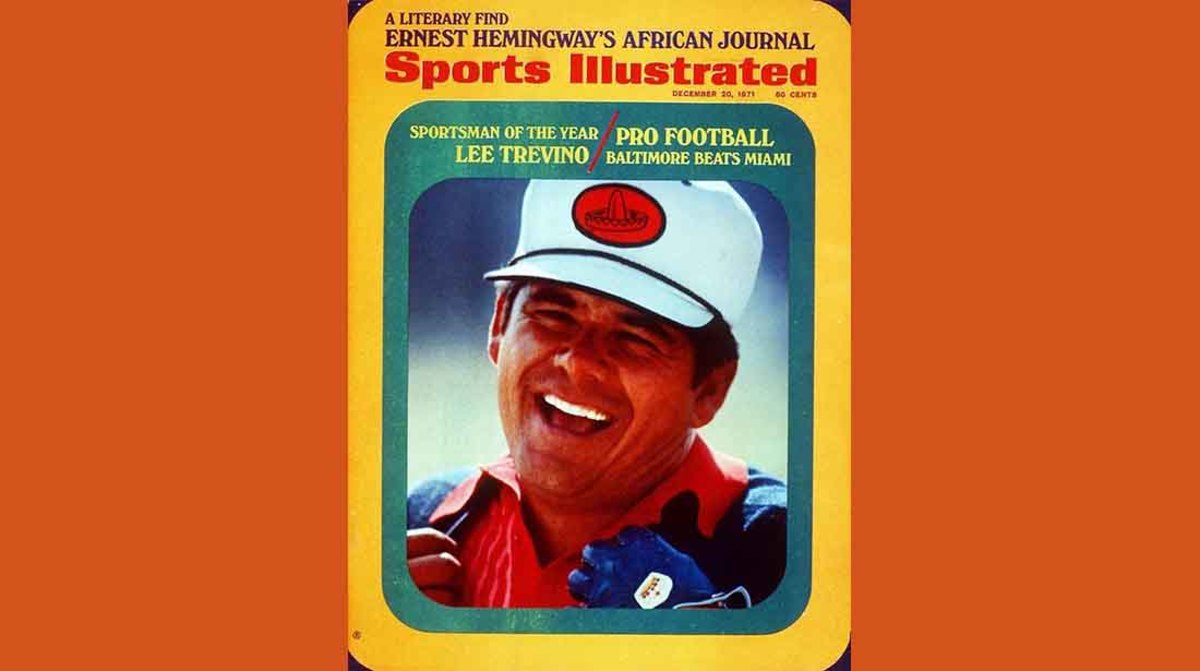A Half-Century Ago, Lee Trevino Reaped the Fruits of a Recommitted Game

ST. LOUIS — Fifty-plus years changes a lot. Lee Trevino still walks into a shot, but the gait has endured four back surgeries. Trevino still has a full head of hair, but the bristles are snow white not jet black. And Trevino still pounds golf balls for two to three hours each day, but at age 82 he’s not preparing for tournaments.
The one thing 50-plus years hasn’t changed is the charm. It still arrives like a landslide, all encompassing, with the sparkling eyes and folksy wit. Trevino isn’t always engaging, but when the switch gets flipped, 50 years may as well be five minutes. It’s still there, big as all outdoors, bright as a flash bulb, full of one-liners.
“I can’t wait to get up in the morning just to hear what I have to say,” Trevino says, as he has before, punctuated with half-moon grins and laughter.
Trevino had a lot to say back in January 1971. He was talking to a young reporter in Seaside, California, feeling good about his game and the year to come. The switch was on, the voltage was high and he became Babe Ruth pointing to center field, Joe Namath promising a Super Bowl, Muhammad Ali predicting a round.
He told the reporter, without a flinch, that he had every intention of winning both the U.S. Open and the British Open. “I just had a feeling that 1971 was going to be my year,” he remembered.

Trevino won three times in 1969 and 1970, stuff that hardly requires revision. But two of the wins were in one place — the Tucson Open. And after winning a U.S. Open at Oak Hill in 1968 — beating Jack Nicklaus by four strokes, Trevino whiffed on his next eight majors.
Players of Trevino’s ilk — cloth that features six major championships and 29 PGA Tour wins — measure success one major at a time. Particularly maddening for the “Merry Mex” was his retreat at the 1970 British Open, where he surrendered a two-shot lead in the final round at St. Andrews.
“I didn’t play extremely well in 1969 and 1970,” Trevino said recently while in St. Louis to promote this week's Champions Tour Ascension Charity Classic at Norwood Hills Country Club, where he'll play Saturday in a celebrity exhibition. “I kind of forgot that what got me there in the first place was hard work. So I started back working again really hard at my craft.”
He also embraced an impromptu pep talk from Nicklaus, who approached him that spring in the locker room at the Doral Eastern Open. The “Golden Bear” didn’t tell his adversary anything he didn’t already know, but he told him something he needed to hear.
“He sat down next to me and he said, ‘You don’t know how good you are, you can win anywhere,’” remembered Trevino. Lack of conviction was never an issue. But when the best player on the planet tells you you’re good, it’s kind of a big deal. “It meant everything; I’ve never forgotten it,” Trevino added.
During the next two seasons, he proved it. He won six times in 1971, which included an unprecedented hat trick. He captured a memorable U.S. Open at Merion, beating Nicklaus in a playoff after cracking him up with a rubber snake on the first tee. Two weeks later, he captured the Canadian Open, a title he would win three times. A week later, he won the British Open at Royal Birkdale.
Twenty days, three Opens, premonition validated.
He became the first to win the three national championships in the same year — a feat later equaled by Tiger Woods (2000). He became the first to capture U.S. and British Opens back to back since Ben Hogan in 1953, and he became Sports Illustrated's "Sportsman of the Year."
Who saw that coming? Well … he did.
“Well, the U.S. Open was at Merion, and I knew a little something about Merion,” Trevino explained. “I had played there before. I knew it was not a big golf course, which I liked. It had two par 5s, and that was all, and it was par 70.”
Trevino also acknowledged help from a rain delay during the playoff, which softened the greens and made them more accommodating to his low-approaching shots. Meanwhile, in July 1971, the British Open he had acquiesced a year earlier was staged at Royal Birkdale, a course that featured five par 5s. But there was a quid pro quo.
In ’71, players still were allowed to employ the “British ball,” a pill that was 0.06 inches smaller in diameter to the USGA version. The small ball was outlawed at the British Open in 1974 before the R&A and USGA standardized the larger ball altogether in 1990.
Until then, those who normally followed USGA guidelines could choose to play the smaller ball in the British Open. Like Trevino, most did, believing it provided slightly more distance and workability in the wind. More distance and workability were music to the ears of a virtuoso ball-striker.
“Anytime I can reach all the par 5s, I’m a pretty dangerous guy,” Trevino recalled. “I can play the par 3s and the par 4s. My problem was playing against long hitters who could reach the par 5s in two, especially Nicklaus. He could reach all five (at Royal Birkdale), but that’s OK. I don’t mind that if I can reach them also.”
Again, Trevino took a lead into the final round and this time he made it stand, beating Taiwan’s Lu Liang-Huan by a shot to add the third Open to his trifecta.
That set the table for 1972, a triumphant repeat at Muirfield and a follow-up season of four more wins. The year got rolling with a win at Memphis in May, then a tie for fourth behind Nicklaus in the U.S. Open at Pebble Beach. Nicklaus appeared unstoppable at that point, having also won the Masters in April.
With consecutive majors, Nicklaus arrived in Scotland staring down a Grand Slam and carrying the “man to beat” label at Muirfield, where he won the previous British Open gathering in 1966. He was at the height of his powers, the reigning champion of the Masters, U.S. Open and PGA — which in ’71 had been played in February. He was at the height of his intimidating powers. But nothing intimidated Trevino, not nobody, not no how.
“I wasn’t intimidated too much with anybody,” Trevino said. “I learned a long time ago, if I looked at a golf course and I felt I could beat it, I played for a score, not for an individual. I can’t help what the individual does.
“I played — not conservative — but I actually played the golf course. I figured out the percentages and I shot the best score I possibly could. If it wasn’t good enough, it wasn’t good enough. Nicklaus did the same thing. Nicklaus could actually look at the golf course and tell you almost to the stroke what was going to win that major championship.”
That summer at Muirfield, the score was 6-under-par 278. Trevino shot it, holing out from off the green four times during the championship, including famously on the 17th hole of the final round. Nicklaus shot 279, one shot shy.
That scenario played out once more in 1974. Trevino won the PGA Championship at Tanglewood Park in North Carolina. The previous year’s champion — Nicklaus — finished one shot back, runner up to Trevino for the fourth time in a major championship. That is, if not for the talkative Texan, Nicklaus’s spectacular career would include 22 professional majors instead of a record 18.
That brought another twinkle to Lee Trevino’s eyes, another wide smile to his face. It’s been 50-plus years now, seems like five minutes.
